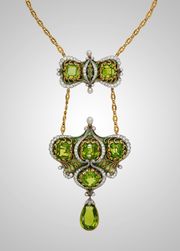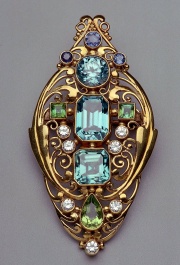Difference between revisions of "Peridot"
m (Text replace - "\[http:\/\/cameo\.mfa\.org\/materials\/fullrecord\.asp\?name=([^\s]+)\s(.*)\]" to "$2") |
|||
| Line 1: | Line 1: | ||
| − | [[File: | + | [[File:Peridot 2016391.jpg|thumb|Peridot necklace<br>MFA# 2016.391]] |
== Description == | == Description == | ||
| − | + | [[File:1998.569-SC8319.jpg|thumb|Jeweled brooch<br>MFA # 1998.569]] | |
A transparent, yellow-green [[gemstone|gemstone]]. Peridot is a transparent form of [[olivine|olivine]] that was known in ancient Greece and in Egypt. Many of the green stones worn by Cleopatra were peridot. The main old world source for peridot was the island of Zabargad (St. John's Island) in the Red Sea. Peridot was called an evening emerald because it appears to lose its yellowish cast at night. It has sometimes been misidentified as emerald and as green glass. Former names include topaz (Greek) and zerberdjet (Persian). Peridots are still obtained from Zabargad and also from Brazil (Minas Gerais), South Africa, Kenya, China, Myanmar (formerly Burma, near Mogok), Norway (Sondmore), and the U.S. (Arizona, Hawaii). | A transparent, yellow-green [[gemstone|gemstone]]. Peridot is a transparent form of [[olivine|olivine]] that was known in ancient Greece and in Egypt. Many of the green stones worn by Cleopatra were peridot. The main old world source for peridot was the island of Zabargad (St. John's Island) in the Red Sea. Peridot was called an evening emerald because it appears to lose its yellowish cast at night. It has sometimes been misidentified as emerald and as green glass. Former names include topaz (Greek) and zerberdjet (Persian). Peridots are still obtained from Zabargad and also from Brazil (Minas Gerais), South Africa, Kenya, China, Myanmar (formerly Burma, near Mogok), Norway (Sondmore), and the U.S. (Arizona, Hawaii). | ||
| Line 8: | Line 8: | ||
olivine; zeberdjet; evening emerald; olivine, péridot (Fr.); peridoto (Esp., Port.); Peridot (Deut.); peridoot (Ned.) | olivine; zeberdjet; evening emerald; olivine, péridot (Fr.); peridoto (Esp., Port.); Peridot (Deut.); peridoot (Ned.) | ||
| − | == | + | == Physical and Chemical Properties == |
Orthorhombic crystal system. | Orthorhombic crystal system. | ||
| Line 35: | Line 35: | ||
[[media:download_file_428.pdf|Properties of Common Gemstones]] | [[media:download_file_428.pdf|Properties of Common Gemstones]] | ||
| − | + | == Resources and Citations == | |
| − | |||
| − | == | ||
* G.S.Brady, ''Materials Handbook'', McGraw-Hill Book Co., New York, 1971 Comment: p. 561 | * G.S.Brady, ''Materials Handbook'', McGraw-Hill Book Co., New York, 1971 Comment: p. 561 | ||
| Line 45: | Line 43: | ||
* R.F.Symmes, T.T.Harding, Paul Taylor, ''Rocks, Fossils and Gems'', DK Publishing, Inc., New York City, 1997 | * R.F.Symmes, T.T.Harding, Paul Taylor, ''Rocks, Fossils and Gems'', DK Publishing, Inc., New York City, 1997 | ||
| − | * Website | + | * Website: http://www.geo.utexas.edu/courses/347k/redesign/gem_notes/Peridot/peridot_triple_page.htm |
* Yasukazu Suwa, ''Gemstones: Quality and Value, Volume 1'', Sekai Bunka Publishing Inc., Tokyo, 1999 | * Yasukazu Suwa, ''Gemstones: Quality and Value, Volume 1'', Sekai Bunka Publishing Inc., Tokyo, 1999 | ||
Revision as of 08:28, 12 August 2020
Description
A transparent, yellow-green Gemstone. Peridot is a transparent form of Olivine that was known in ancient Greece and in Egypt. Many of the green stones worn by Cleopatra were peridot. The main old world source for peridot was the island of Zabargad (St. John's Island) in the Red Sea. Peridot was called an evening emerald because it appears to lose its yellowish cast at night. It has sometimes been misidentified as emerald and as green glass. Former names include topaz (Greek) and zerberdjet (Persian). Peridots are still obtained from Zabargad and also from Brazil (Minas Gerais), South Africa, Kenya, China, Myanmar (formerly Burma, near Mogok), Norway (Sondmore), and the U.S. (Arizona, Hawaii).
Synonyms and Related Terms
olivine; zeberdjet; evening emerald; olivine, péridot (Fr.); peridoto (Esp., Port.); Peridot (Deut.); peridoot (Ned.)
Physical and Chemical Properties
Orthorhombic crystal system.
Fracture = conchoidal to uneven. Luster = vitreous. Streak = colorless.
Fluorescence = none
| Composition | (Mg,Fe)2SiO4 |
|---|---|
| Mohs Hardness | 6.5 |
| Density | 3.22-3.40 |
| Refractive Index | 1.650-1.690 |
Comparisons
Properties of Common Gemstones
Resources and Citations
- G.S.Brady, Materials Handbook, McGraw-Hill Book Co., New York, 1971 Comment: p. 561
- Jack Odgen, Jewellery of the Ancient World, Rizzoli International Publications Inc., New York City, 1982
- R.F.Symmes, T.T.Harding, Paul Taylor, Rocks, Fossils and Gems, DK Publishing, Inc., New York City, 1997
- Yasukazu Suwa, Gemstones: Quality and Value, Volume 1, Sekai Bunka Publishing Inc., Tokyo, 1999
- Michael O'Donoghue and Louise Joyner, Identification of Gemstones, Butterworth-Heinemann, Oxford, 2003

